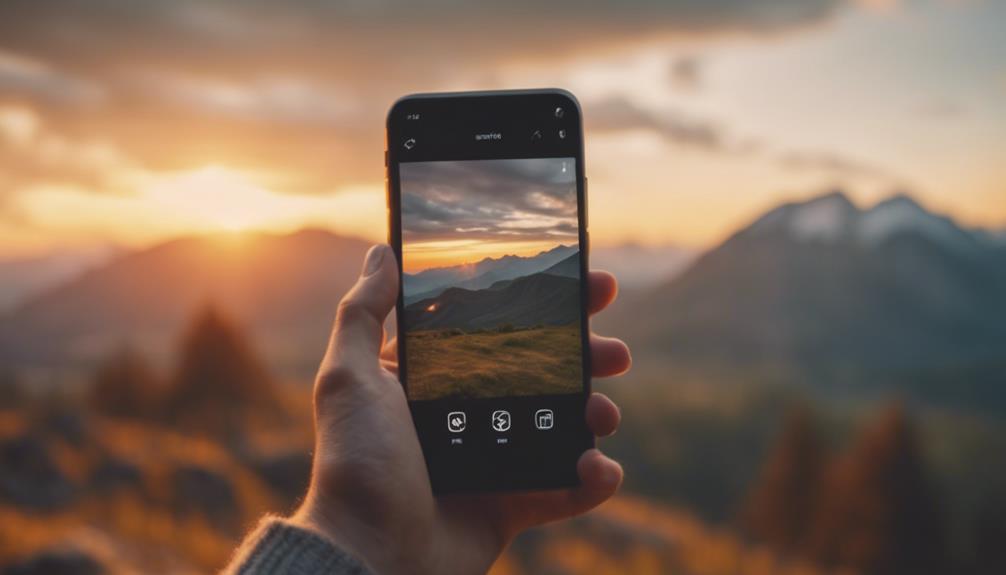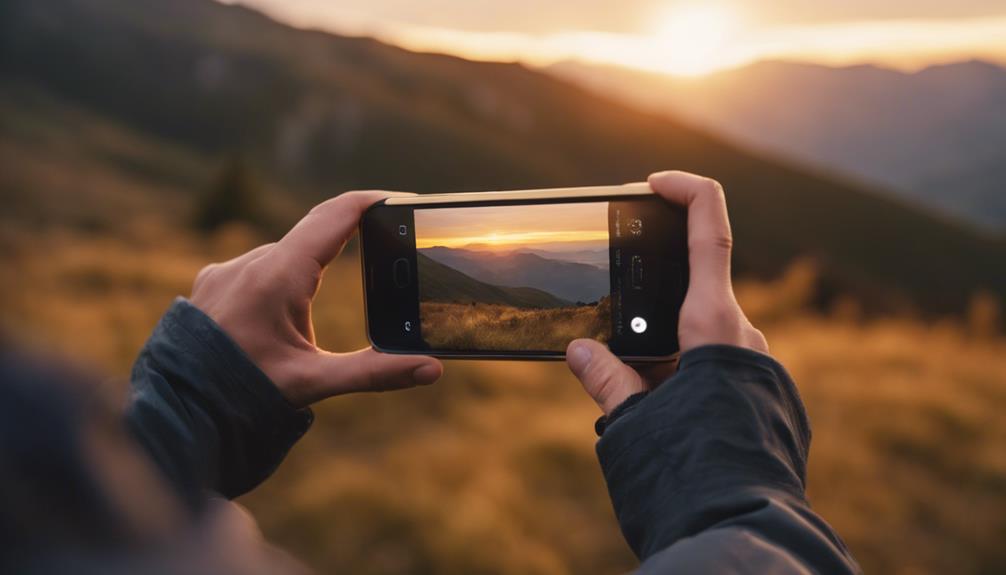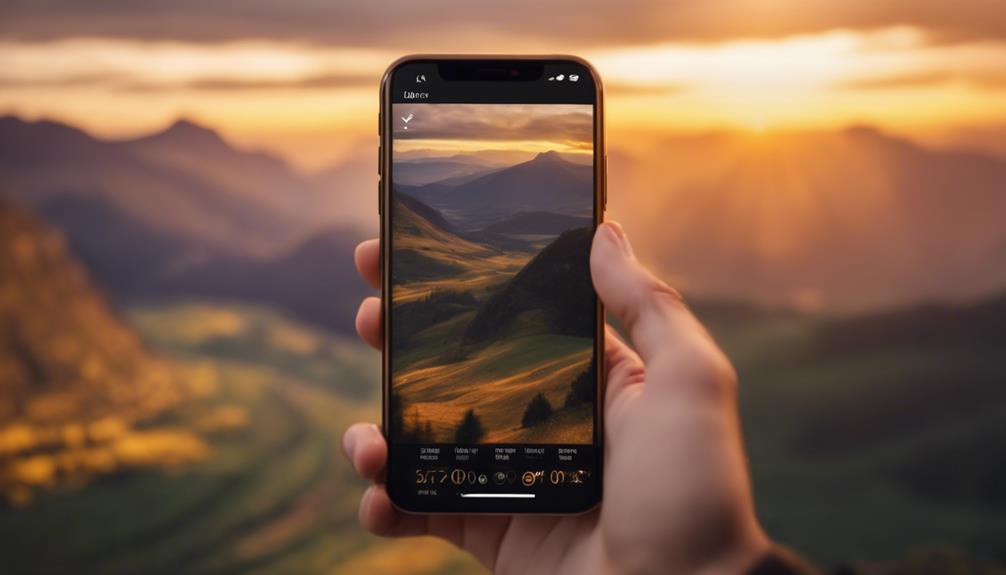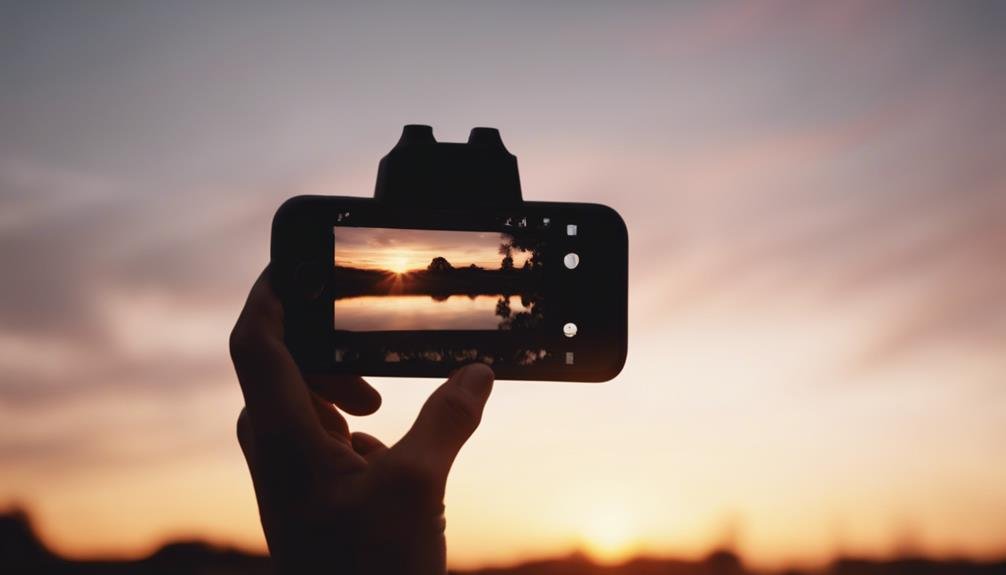To capture stunning landscape photos with your smartphone, start by honing a few key techniques. Begin by utilizing the golden hours at sunrise and sunset when the light is soft and colors are vibrant. Employ the rule of thirds to compose your shots, placing key elements at intersections to create balance. Keep your ISO low to reduce grain, and adjust the shutter speed to capture movement effectively. Don't forget to tap your screen to focus or use manual focus for clearer, crisper images. Experimenting with these simple yet powerful tips will enhance the depths and dynamics of your landscape photography. Discover more as you explore these strategies further.
Understanding Your Phone's Camera

Before starting on capturing stunning landscapes, it's important to familiarize yourself with your phone's camera capabilities. Understanding the array of camera settings available can greatly enhance the quality of your photos. Begin by exploring the ISO and shutter speed options. A lower ISO minimizes grain in your images, ideal for the bright, expansive views in landscape photography. Conversely, adjusting the shutter speed affects how movement is captured, allowing you to experiment with everything from crisp, frozen motion to a silky smooth appearance in moving elements like water.
Delve into focus techniques to make sure every detail is vivid. Most smartphones offer a tap-to-focus feature, enabling you to pinpoint exactly where you want sharpness in your frame. For landscapes, focusing a third into the scene usually yields a sharp foreground and background. If your phone has it, activate the manual focus for finer control, perfect for handling complex scenes with varying depths.
Lastly, don't overlook exposure adjustments. Many phones allow you to manually tweak exposure, ensuring your landscapes aren't too dark or overwhelmingly bright. Swipe up or down on the screen while in camera mode to find the perfect balance. With these tools at your disposal, you're ready to transform ordinary scenes into breathtaking masterpieces.
Mastering Composition Basics
Understanding the fundamentals of composition is essential as you aim to capture landscapes that resonate and inspire. One of the most effective techniques to enhance your landscape photography is mastering the rule of thirds. Imagine your frame divided into nine equal parts by two horizontal and two vertical lines. Placing key elements of your landscape along these lines or at their intersections can create a pivotal, visually appealing image that draws the viewer's eye through the scene.
Incorporating foreground interest is another vital component. By including elements like rocks, flowers, or a winding path in the foreground, you give your photos depth and context, making the scene more engaging. It's not just about capturing the vastness of a landscape but inviting viewers to step into the frame and experience the place as if they were there with you.
Utilizing Natural Light

Now that you've grasped composition basics, let's explore how you can harness natural light to dramatically enhance your landscape photos. Natural light isn't just about brightness; it's about mood, tone, and texture. Understanding lighting angles plays a vital role. When light hits your landscape from different angles, it creates varying effects and shadows, adding depth and intrigue to your images. You'll notice how sidelight accentuates textures dramatically, while backlight can silhouette subjects to create striking contrasts.
Shadow play is another technique to master. Shadows aren't merely absences of light; they're shapes and stories waiting to be captured. By observing how shadows fall across different terrains and times of day, you can use them to lead the eye or frame your main subjects compellingly. This interplay between light and shadow not only gives your photos a sense of dimension but also evokes emotion.
Best Times for Landscape Shots
To capture the full glory of landscapes, consider the magic hours of sunrise and sunset when the light is soft and colors are vibrant. These times, often called the 'golden hours,' create a natural, diffused light that dramatically enhances your landscape photos. The soft glow adds depth and texture, making your photos pop without the need for any fancy gear.
Here are a few tips to make the most of these prime times:
- Check the Weather: Weather conditions greatly impact the quality of light. A partly cloudy day can lead to dramatic sunrises or sunsets, with the clouds beautifully diffusing the light. Conversely, an overly cloudy day mightn't provide the dramatic lighting you're hoping for, so it's good to plan ahead.
- Understand Seasonal Variations: The position of the sun changes with the seasons, which affects the timing of the golden hours. In summer, you might find yourself waking up very early for sunrise, while in winter, the sun sets earlier, ideal for those who aren't night owls.
- Scout Your Location in Advance: Visit your chosen location beforehand during different times to see how the light plays with the landscape. This preparation ensures you're ready to capture the best shot when the conditions are optimal.
Editing Tips and Apps

Once you've captured your landscape photos during the golden hours, it's time to enhance their beauty with the right editing tools and techniques. You don't need to be a professional; with your smartphone and some savvy app choices, you can elevate your images effortlessly.
First, explore apps like Adobe Lightroom or VSCO, which are popular for their user-friendly interfaces and powerful editing capabilities. These apps offer a range of preset adjustments that can instantly transform the mood and quality of your photos. Whether you're looking to bring out the vibrant colors of a sunset or the subtle textures in the clouds, presets can provide a great starting point.
Next, delve into the manual adjustments. Tweak the exposure or contrast to bring out the details in your shadow and highlight areas. Don't forget to play with the saturation to make your colors pop or appear more natural, depending on the look you're aiming for.
Capturing Diverse Environments
How can you effectively capture the essence of diverse environments, ranging from arid deserts to lush rainforests, using just your smartphone camera? The key lies in understanding the unique characteristics of each location and how the elements interact within those spaces. Adapting to these conditions with your mobile device can be straightforward if you keep a few critical tips in mind.
Here are three practical steps to enhance your landscape photography:
- Understand Weather Impact: Always check the weather forecast before you head out. Dramatic weather can add a layer of depth and emotion to your photos. For instance, capturing the way light breaks through clouds after a storm can dramatically alter the mood of a landscape.
- Master Location Scouting: Spend time exploring your chosen location. Look for unique angles and perspectives. Walking around might reveal hidden vantage points that perfectly frame the natural beauty of the environment.
- Optimize Lighting Conditions: The golden hours, just after sunrise and before sunset, provide soft, diffused light that can make even the simplest landscapes look breathtaking. Utilize these times to capture warm tones and elongated shadows that can define the topology of the terrain.
Learning From Common Mistakes

Recognizing and learning from common mistakes can dramatically improve your landscape photography skills. One frequent error is ignoring weather conditions. You might think a clear, sunny day is perfect, but overcast skies often create more balanced light and bring out the vibrant colors of nature. Don't let a cloudy forecast discourage you; instead, use it to capture unique, moody shots that shine with depth and emotion.
Another common oversight is neglecting foreground details. It's easy to get swept away by the grandeur of mountains or the expanse of the sea, but the foreground is your storytelling ground. It adds depth and leads the viewer's eye into the scene. Try incorporating rocks, leaves, or even a winding path as a focal point. These elements not only enhance the composition but also give a sense of scale and the beauty of the details within the environment.
Frequently Asked Questions
How Can I Prevent My Phone From Overheating While Taking Photos Outdoors?
To prevent your phone from overheating while taking photos outdoors, follow these heat management tips:
- Avoid direct sunlight by seeking shade or using an umbrella.
- Use a small, portable fan to keep the device cool.
- Minimize background app usage and lower your screen brightness.
These overheating solutions not only safeguard your phone but guarantee you can keep capturing those stunning shots without interruption.
Stay inspired and keep exploring with confidence!
Are There Legal Restrictions for Photographing Certain Landscapes?
Yes, you'll find legal restrictions when photographing certain landscapes.
Privacy concerns play a big role, especially around private properties or restricted areas. Additionally, national parks or historic sites often require permits.
Always check local regulations to make sure you're compliant. This not only protects you legally but also respects the environment and communities you're capturing.
What Are Eco-Friendly Photography Practices?
To practice eco-friendly photography, you'll want to master natural lighting techniques and show respect for wildlife. Harness the golden hours—sunrise and sunset—to capture soft, natural light that enhances your landscapes.
Always maintain a safe distance from animals, using your zoom to fill the frame. By minimizing your ecological footprint and using natural resources wisely, you contribute to the preservation of the scenes you're capturing, ensuring they remain untouched for future generations.
How to Manage Battery Life During Long Photography Sessions?
Did you know that the average smartphone battery depletes by 5-10% per hour during continuous camera use? To manage this during long photography sessions, you'll need a solid charging strategy.
Start by investing in a high-capacity power bank. This portable charger can be a game changer, allowing you to recharge your phone multiple times in the field.
Always start with a fully charged phone and power bank to maximize your shooting time and capture those perfect shots!
Can I Use My Phone's Digital Zoom Effectively for Landscapes?
You can use your phone's digital zoom for landscapes, but be mindful of zoom limitations and potential image degradation. Digital zoom can reduce the clarity and detail of your photos, as it fundamentally crops and enlarges the image digitally.
Instead, try to move closer to your subject or capture the scene in its broader context, which can yield more stunning and high-quality results. Embrace the challenge and let your creativity soar!
Conclusion
Ready to transform your everyday surroundings into breathtaking masterpieces with just your phone? Remember, it's not about having the fanciest gear but knowing how to use what you've got.
Why not explore the golden hour for that perfect shot or play with composition to tell a richer story? Keep experimenting with the tips and apps suggested, and learn from each snap.
Every landscape offers a unique canvas—embrace it, capture it, and most importantly, enjoy the journey of your photographic exploration!

